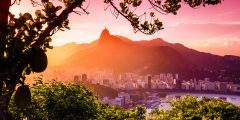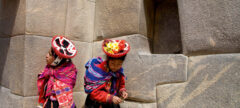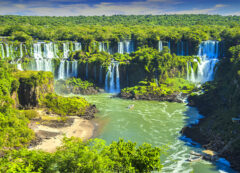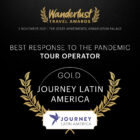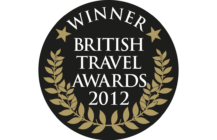Private Journeys
Signature Peru and Brazil: Machu Picchu and Rio de Janeiro
12 days from £3,910pp
(based on two people sharing & excluding flights)
Essentials
-
Tour info
-
Country info
-
What's included
Tour info
Transport
3 flights (may vary depending on seasonal connections); 2 rail journeys (longest 4hrs).
Accommodation
This holiday uses a choice of first class hotels, a mix of historic and contemporary style with well-equipped rooms, excellent facilities and stunning locations.
Meals
Breakfast daily; lunch days 4 and 5; dinner day 5.
Guides
We carefully select our local partners, some of whom we have worked with for over 25 years. Their English-speaking guides understand the expectations of our clients very well, and are consistently singled out for praise by the latter on their return.
Summary Of Nights
12 days, 11 nights: Lima 2; Urubamba 2; Machu Picchu 1; Cusco 3; Rio de Janeiro 3.
Currency
The unit of currency in Peru is the sol; in Brazil it’s the real (plural: reais).
How To Take It
Cash machines are available in all major cities and towns, and so taking a debit or credit card with a PIN number is the most convenient way of withdrawing money while on your trip, and in most shops and restaurants you can also pay by card. However, since cards can get lost, damaged, withheld or blocked, you should not rely exclusively on a card to access funds.
We recommend that additionally you take a reasonable quantity of US dollars cash (no more than is covered by your insurance), which you can exchange into local currency, and possibly some travellers’ cheques (American Express are the most widely accepted), though these are gradually falling out of use. Dollar bills should be in good condition, soiled or torn bills may be refused. You can take sterling, but the exchange rate is not always competitive or even available, restricting the number of places where you can change money.
Daily Spend
It is very difficult to give a guideline for essential expenses but a budget of around US$50 per person, per day should cover the cost of meals not included in the holiday itinerary, drinks and the odd souvenir. Eat at the best restaurants and you will pay considerably more.
Tipping
Tips are welcomed and local guides often rely on their tip as a significant proportion of their income.
Most service industry workers will expect a tip of some kind and so it is useful to have spare change for hotel porters, taxi drivers and the like. It is common to leave 10 – 12% in restaurants.
Tipping guidelines can be found in our Briefing Dossier.
Insurance
Travel insurance is essential.
Details of our recommended policy can be found on our Travel Insurance page.
Airport Taxes
If you have purchased your flights through Journey Latin America, the international departure tax is usually included in the ticket.
Trip Suitability
This is a fairly leisurely tour, although it visits a number of places in a short time. Greater distances are travelled by air. Drives are relatively short and scenic, stops possible.
The stay in the Andes is at altitudes of between 2,800 and 3,500m (see the paragraph “Altitude” below).
Climate
The rainy season in the Andes runs between November and March when there are showers many afternoons. The dry season is from May to September, when the sun is strong during the day, but at night the temperature drops dramatically (from freezing to 10°C). April and October are less predictable, with both rainy and sunny spells.
In sub-tropical Rio, December to March are the hottest and most humid months, with temperatures sometimes reaching 40°C, and rain which falls in brief, heavy showers. From June to September, temperatures are more moderate (18-23°C) and there is plenty of sunshine, but cold fronts can usher in periods of up to several days of cloud and drizzle in Rio.
Altitude
Your stays in Cusco and the Sacred Valley are at high altitude (2,800-3,300m). A small minority of visitors may suffer temporarily from altitude sickness. Symptoms vary; most common are mild headaches, slight nausea and breathlessness. If you don’t recover in a day or two speak to our representatives; in very rare instances it is necessary to descend to lower altitudes. Most people are unaffected and if you drink plenty of water and allow your body to acclimatise (don’t exert yourself or drink alcohol) in the first couple of days after arrival, you will minimise your chances of suffering any symptoms.
Please refer to our Briefing Dossier for further information.
Clothing And Special Equipment
For day-to-day wear you should go prepared to encounter all seasons. Both warm clothing and a sun hat are essential at altitude; a light fleece jacket and a Gore-Tex outer shell makes a good combination. Trousers, skirt or shorts made from light, quick-drying synthetic materials work well. If you plan to eat in smart restaurants, although clothing is not formal (no need for jacket and tie), something quite smart would be appropriate.
If you are travelling in the southern summer you’ll only need summer clothing for Brazil, plus beachwear and an umbrella. Winter in Rio (June-August) is less predictable and can be a bit chilly, though never cold.
Strong, comfortable footwear is essential and you should bring insect repellent, sun block and sun glasses.
Due to luggage restrictions on the train to Machu Picchu, main luggage must be left in Cusco. You can take up to 10kgs per person on the train and an overnight holdall is recommended to separate your luggage for the night spent away from Cusco.
Please get in touch with the office before departure if you have any doubts. Good equipment is very important and hard to come by in South America.
Vaccinations
Preventative vaccinations are recommended against the following; typhoid; polio; tetanus; hepatitis A. For specific requirements you must consult your GP.
As of 2018, visitors to Brazil travelling on our holidays should be protected with a vaccination against yellow fever, and carry the corresponding certificate. In April 2013, the World Health Organisation Strategic Advisory Group of Experts on Immunisation concluded that a single primary dose of yellow fever vaccine is sufficient to confer sustained immunity and lifelong protection against yellow fever disease, and that a booster dose is not needed.
You can also find helpful information on the Masta Travel Health website.
Visas
Holders of a full British passport do not require a visa, although passports must be valid for at least 6 months after the trip begins. Anyone with a different nationality should enquire with us or check with the relevant consulate.
If flying to the US, or via the US you will need to fill in your online ESTA application.
Country info
When is the best time to visit Peru?
The best time to visit the Andes is April to October, the dry season but at this time it is misty and chilly in Lima. The jungle is an all-year destination, as is Arequipa and the Colca Canyon.
What is Peru's official language?
The official language spoken in Peru is Spanish.
What is Peru's official currency?
The official currency of Peru is the Peruvian Nuevo Sol. Notes in local currency or US dollars can be withdrawn from the many ATMs using a UK credit or debit card. Numerous money exchange offices exchange US dollar cash (few accept euros or sterling and the rate may be poor).
What is the time difference between Peru and the UK?
The time difference between the UK and Peru is GMT-5 hours.
Do I need a visa to travel to Peru?
Holders of a full British passport do not require a visa, although passports must be valid for at least 6 months after the trip begins. Anyone with a different nationality should enquire with us or check with the relevant consulate. If flying to the US, or via the US you will need to fill in your online ESTA application.
What vaccinations are recommended for visiting Peru?
Please check https://travelhealthpro.org.uk/ for information on health recommendations and vaccinations for the destinations you are visiting. Please note that many Latin American countries require proof of vaccination against Yellow Fever if you have recently travelled to another country where Yellow Fever is present.
Which other countries combine well with Peru?
The Galapagos Islands combine well with Peru, as there are flights from Lima connecting through Guayaquil, Ecuador.
What are the festivals, cultural and sporting events in Peru?
Semana Santa (Easter): Many places throughout the country, Mar-Apr variable. Religious processions.
Inti Raymi, Cusco (24 Jun) Theatre and re-enactments of Inca history in the ruins of Sacsayhuamán, the temple fortress overlooking Cusco.
How do I adapt to the altitude in Peru?
Peru's high Andean spine is bookended by the Pacific coast and Amazon Rainforest, with Cuzco at 3,300m. Travel to high altitude can cause mountain sickness and even if you feel fighting fit it’s important to take things easy and stay hydrated (drink plenty of water, avoiding alcohol and caffeine) as you get used to the thin, dry air. You may initially notice a headache, dizziness or breathlessness and this usually improves with acclimatisation. If you are pregnant or taking the contraceptive pill, have a medical condition such as heart or lung condition, anaemia, asthma, high blood pressure you should seek the advice of your GP before booking. We also recommend you check your travel insurance covers travel to high altitude. If you’re taking the family, remember small children may be less capable of communicating altitude-related symptoms effectively: keep an eye on them too. Rest assured we will plan your itinerary carefully, taking into account any time spent at altitude. If you have any questions or concerns about altitude please speak to your travel expert.
Further advice on travel to altitude is available on www.travelhealthpro.org.uk
When's the best time to visit Brazil?
Brazil is an all-year destination, but it’s a vast country: when you go will depend on your chosen itinerary and interests. Late Dec-Mar are the hottest months – very hot (over 40°C) from Rio northwards – and the local holiday season, so attractions can be very busy. During the Amazon’s wet season (Jan - Jun) it’s easier to get round by boat, the dry season is sunnier and better for wildlife-spotting but very hot. The Pantanal may be best avoided during the wettest months (Nov - Mar) when there are many mosquitoes. However this is the best time to visit the beaches of the south where it’s cool outside this period.
For more detailed information visit our When To Go section.
What's the official language of Brazil?
The official language of Brazil is Brazilian Portuguese; a more languid and musical version of Portugal's mother tongue. You will also find indigenous languages spoken in Amazonia.
How do I get local currency in Brazil?
The local currency in Brazil is the Brazilian Real. Notes can be withdrawn from the many ATMs at airports and in larger towns and cities. Limits may be lower than your UK bank allows. Banco do Brasil, HSBC accept UK credit or debit cards allowing daily withdrawals of 1,000reais. Bradesco allows a lower limit. Other banks eg Banco 24horas do not accept foreign cards. Most towns have a Banco do Brasil. ATMs close at 10pm. Currency is also obtainable in banks and money exchanges.
What is the time difference between Brazil and UK?
The time difference between the UK and Brazil is GMT -3 hours. There is daylight saving from Oct- end Feb (approx) when clocks are put forward one hour.
Do I need a visa for Brazil?
Holders of a full British passport do not require a visa, although passports must be valid for at least 6 months after the trip begins. Anyone with a different nationality should enquire with us or check with the relevant consulate.
If flying to the US, or via the US you will need to fill in your online ESTA application.
What vaccinations do I need for Brazil?
Please check Travel Health Pro for information on health recommendations and vaccinations for the destinations you are visiting. Please note that many Latin American countries require proof of vaccination against Yellow Fever if you have recently travelled to another country where Yellow Fever is present.
What are the festivals, cultural and sport events in Brazil?
Carnival offers 5 days of celebration in Feb/Mar. Live bands, costume balls, over-indulgence and general frivolity will take place in towns and cities all over the country. The best parades are in Rio, Salvador and Olinda.
Which countries combine well with Brazil?
Argentina: The crossing at Iguazú Falls is convenient for many visitors.
Peru: There is a direct flight from Lima to Rio de Janeiro (5 hours) and to São Paulo (4-5 hours with many connections to other cities).
Inspired by this trip
Our exciting range of articles on Latin America explore everything from iconic destinations and lesser-known cultural gems to delicious traditional recipes. You’ll also find exclusive travel tips, first-hand client reviews and the chance to get your personal questions answered by our travel experts.
Papagaio
Your edit for Latin American inspiration
Our exciting range of articles on Latin America explore everything from iconic destinations and lesser-known cultural gems to delicious traditional recipes. You’ll also find exclusive travel tips, first-hand client reviews and the chance to get your personal questions answered by our travel experts.
View Extraordinary Inspiration

